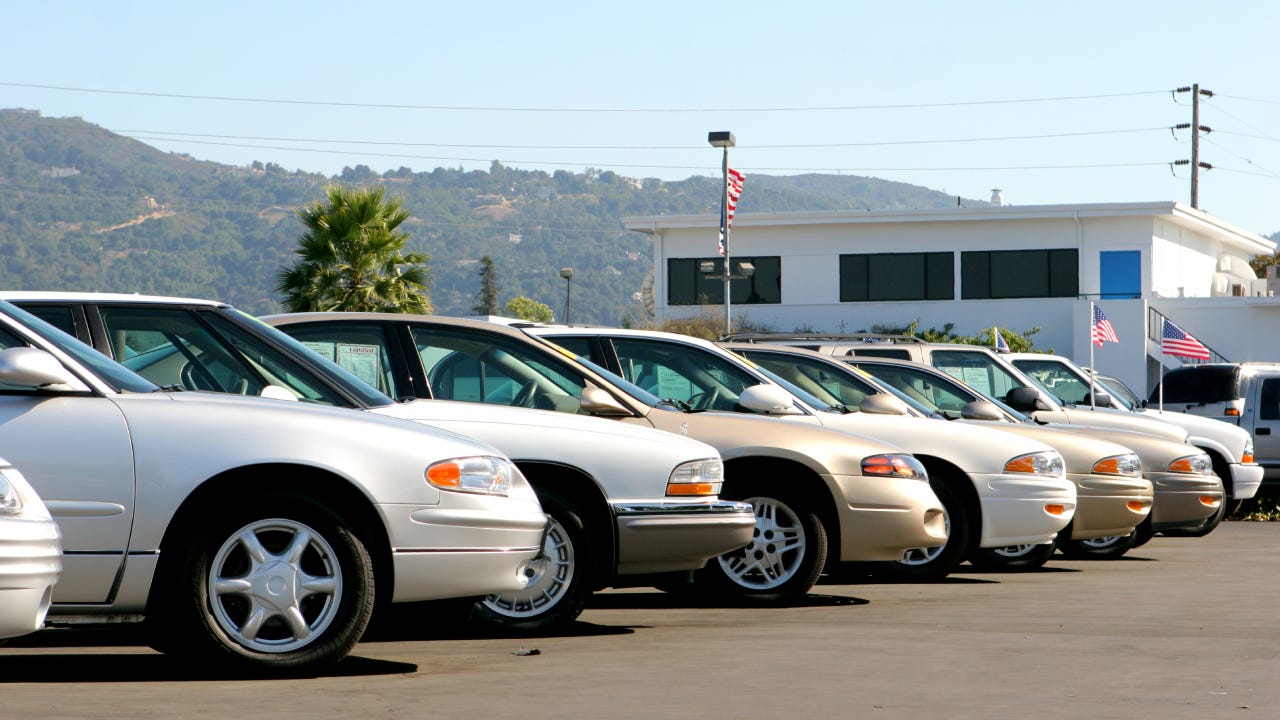
The Bankrate promise
At Bankrate, we strive to help you make smarter financial decisions. To help readers understand how insurance affects their finances, we have licensed insurance professionals on staff who have spent a combined 47 years in the auto, home and life insurance industries. While we adhere to strict , this post may contain references to products from our partners. Here's an explanation of . Our content is backed by Coverage.com, LLC, a licensed entity (NPN: 19966249). For more information, please see our .
Buying a used car is typically more affordable than purchasing a new car. That includes expenses like car insurance for used cars, which typically offers lower premiums than insuring a new vehicle. When insuring a used car, you’ll need to consider the level of coverage that you need. Your premium will vary depending on the type of car you drive as well as factors including where you live and your driving history. Regardless of the variables, insuring a used car will typically be cheaper than insuring a new car—or the fines you may face if you are found to be driving without valid car insurance.
Car insurance for used cars
Before you purchase a used car, you’ll need to think about your car insurance policy, which provides financial protection in case of covered accidents or other incidents on the road. In nearly every state, you’ll be required to provide proof of insurance before taking a used vehicle home from the dealership.
Adding the car to your current policy may not always be the cheapest route. In many cases, it may benefit you to shop around and get quotes from your current insurer and a handful of other insurance companies so you can compare coverage options and cost.
If you don’t have car insurance, you’ll need to shop for a policy, and you won’t be able to drive the car off the lot until you have a policy. Once you have an active car insurance policy in place on the used vehicle, you can take it to the car dealership as proof of insurance.
How long do you have to get insurance after buying a used car?
If you already have a car and a car insurance policy, most insurance companies offer a grace period of automatic coverage for newly acquired vehicles, so you may not necessarily have to add a newly purchased car to your policy before driving it off the lot. However, you typically only have a short period of time (typically between a week to 30 days) in which your current policy will cover the new vehicle, so you should add it to your policy as soon as possible. Check with your insurance provider to see what your grace period is.
Types of coverage for used cars
Every vehicle must carry at least the legally required minimum insurance coverage. Car insurance laws vary from state to state. Required coverage types may include:
- Bodily injury liability
- Property damage liability
- Medical payments
- Uninsured/underinsured motorist coverage
- Personal injury protection (PIP)
Liability coverage types do not apply to you or your vehicle, but instead are designed to cover damages you cause to other people and vehicles with your car. Some states also require motorists to carry uninsured and underinsured motorists coverage, to protect them in the event of an accident with an uninsured or underinsured driver. Keep in mind that uninsured motorist coverage comes in two separate coverage types for bodily injury and property damage.
Depending on where you live, you may also be required to have PIP coverage, particularly if you live in a “no-fault” state. PIP covers medical expenses and lost wages for you and your passengers, regardless of fault. There are 12 no-fault states in the U.S., and if you live in one of them, you must have PIP insurance along with the minimum coverage.
Do you need full coverage on a used car?
Full coverage car insurance policies include comprehensive and collision coverage. Comprehensive coverage covers the cost of damage that is the result of things like weather, theft, vandalism, hitting an animal and other conditions that may not be caused while driving. Collision coverage pays for damages that occur during a collision, whether it is with another car, into property, a tree or another object.
These types of coverage are not required unless you lease or finance your vehicle, but you may choose to have these policies to cover any potential damage to your own vehicle if it is not covered by someone else’s insurance. As a general rule, you may want this coverage to cover the actual cash value of your vehicle. If the actual cash value of your car is $1,000 and the collision deductible costs $500 per year, then it may not be worth it to pay for collision coverage. But if the car is valued at $10,000, you likely will want to protect against collision damage. Talk to your insurance agent about whether full coverage insurance is right for your used car.
Cost of insurance for used cars
There are a number of factors that an insurance company will consider when determining the cost of your car insurance policy. While some of these factors are related to decisions that you have made, others may be beyond your control. Factors that impact your car insurance premium can include:
- Credit history*
- Location
- Prior car insurance claims
- Driving record
- Age*
- Gender*
- Vehicle type
*In some states, insurers are not allowed to consider these factors.
How much is full coverage insurance on a used car?
Different insurance providers have different prices, so comparing quotes from multiple companies is typically the best way to ensure you get the coverage you need without breaking the bank. As of 2023, the average cost of car insurance in the United States is $2,014 per year for full coverage car insurance, according to Bankrate’s analysis of average rate data from Quadrant Information Services. This average rate is based on a 2021 Toyota Camry. Actual rates will vary by location, insurance company and your specific used car and driver considerations.
How much is minimum coverage insurance on a used car?
Much like full coverage insurance, minimum coverage insurance on a used car will vary depending on a number of factors. According to Bankrate analysis of average rate data, the average cost of minimum coverage insurance is $622 per year in the United States.
How to save money on car insurance for a used car
There are a number of ways to potentially save money on car insurance for a used car, including discount opportunities made available by car insurance providers. Discounts on car insurance policies have different criteria to qualify and include:
- Driver-based discounts: These are made available based on personal characteristics, such as a student discount or a military discount.
- Driving-based discounts: Some insurance providers offer potential discounts to drivers with good driving records. You may also enroll in a telematics program to allow your driving habits to be tracked, which could result in lower rates when you drive safely or drive fewer miles. Keep in mind that some telematics programs can also raise your rates if you exhibit unsafe driving habits.
- Vehicle-based discounts: Having a vehicle that includes certain safety features that are likely to reduce the risk of serious injury in case of a crash or deter theft can result in a discount on your premium. Some safety feature-based discounts can be negated, however, if the safety feature is expensive to replace.
- Bundling discounts: Bundling insurance policies for multiple cars or for different insurance types, such as home and auto, with the same provider can typically earn you a fairly significant discount.
- Billing discounts: Some insurance providers offer discounts to those who enroll in auto-pay to pay their premiums. You may also be able to get a discounted rate by paying your insurance in one lump sum rather than monthly payments or for enrolling in paperless billing.
How to get insurance when buying a used car
When you buy a used car, one of the first things you need to do is get insurance. You cannot legally drive a vehicle without insurance. All drivers must meet the minimum insurance requirements in their state, but many insurance professionals recommend considering a policy with additional coverage or higher limits for better financial protection. And, if you finance your used vehicle, your lender will likely require you to purchase a full coverage insurance policy.
As you shop for your used car, you can shop around for the most affordable car insurance rates by getting personalized quotes from a range of insurers. Each insurance company calculates car insurance rates differently, and rates also vary based on the make and model of your car and other factors, so your rate will likely differ from one company to the next.
When you are ready to buy a car insurance policy, you will need to provide the company with the car’s VIN and the date of purchase. Make sure you understand what is and is not covered and ask for confirmation of your coverage. If you are purchasing a new policy, your insurance coverage should go into effect immediately once you have paid at least your first month’s premium. If you’re adding a vehicle to your existing policy, you won’t have to pay anything when adding the car because the increased cost will be wrapped up in next month’s bill. In turn, you should be able to get proof of insurance and start driving your car.
Frequently asked questions
-
-
Whether your car is used or brand new, you will need at least the minimum coverage to be able to drive it legally. Drivers who are financially able to purchase higher liability limits should do so, as minimum coverage does not guarantee that all expenses from a loss will be covered by the insurance.
-
In the United States, the average cost of car insurance is $622 per year for minimum coverage and $2,014 per year for full coverage, according to Bankrate’s analysis. However, the cost of car insurance will differ from one insurer to another and will change depending on your personal rating factors and coverage needs, so your cost will almost certainly differ from the average cost of car insurance nationwide. To find the best car insurance rates for your specific situation, it may be helpful to shop around and get quotes from a number of different providers.
-
Related Articles



